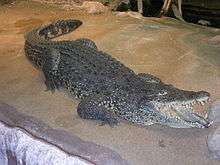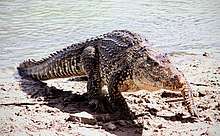Cuban crocodile
The Cuban crocodile (Crocodylus rhombifer) is a small-medium species of crocodile found only in Cuba. Typical length is 2.1–2.3 m (6.9–7.5 ft) and typical weight 70–80 kg (150–180 lb). Large males can reach as much as 3.5 m (11 ft) in length and weigh more than 215 kg (474 lb). Despite its modest size, it is a highly aggressive animal, and potentially dangerous to humans.
| Cuban crocodile Temporal range: Upper Pleistocene-recent | |
|---|---|
 | |
| Scientific classification | |
| Kingdom: | Animalia |
| Phylum: | Chordata |
| Class: | Reptilia |
| Order: | Crocodilia |
| Family: | Crocodylidae |
| Genus: | Crocodylus |
| Species: | C. rhombifer |
| Binomial name | |
| Crocodylus rhombifer Cuvier, 1807 | |
 | |
| Cuban crocodile range | |
The Cuban crocodile is of interest to biologists, for its unique physical and behavioral traits. Long- and strong-legged, it is the most terrestrial of extant crocodiles. Its preferred habitat comprises freshwater environments such as marshes and rivers. There, the adults feed on fish, turtles and small mammals, while the young eat invertebrates and smaller fish. Mating occurs between May and July. Captive animals have displayed cooperative hunting behavior, and can be taught tricks, suggesting intelligence.
The Cuban crocodile is listed as Critically Endangered by the International Union for Conservation of Nature. Once spread across the Caribbean, its range has dwindled to including only the Zapata Swamp and Isla de la Juventud, due to hunting by humans. Captive breeding projects are in place to help the species recover. The species fossil record reveals it had at one point a greater range, with fossil remains being found in the Bahamas,[2] Dominican Republic, and Cayman Islands.[3]
Characteristics
The Cuban crocodile has numerous characteristics that set it apart from other crocodilians, such as its brighter adult colors, rougher, more 'pebbled' scales, and long, strong legs. This is a small to mid-sized crocodilian. Typical adults were found to have measured 2.1–2.3 m (6.9–7.5 ft) in length and to have weighed 70–80 kg (150–180 lb).[4] Large males can reach as much as 3.5 m (11 ft) in length and weigh 215 kg (474 lb) or more.[5]
Distribution and habitat
Today, the Cuban crocodile can only be found in Cuba's Zapata Swamp and Isla de la Juventud, where it is highly endangered. It formerly ranged elsewhere in the Caribbean. Fossils of this species have been found in the Cayman Islands,[6] the Bahamas[7][8] and the Dominican Republic.[9]
The Cuban crocodile appears to favor freshwater habitat such as swamps, marshes, and rivers and rarely swims in saltwater.[10]
Biology and behavior
This species has been observed to display interesting behavior that other crocodilians do not. A colony of this species at Gatorland, Florida, has exhibited what is strongly suspected to be pack-hunting behavior, which may explain the predation of prehistoric megafauna that coexisted with this species, such as the giant sloth. The behavior has prompted much interest in the species, usually kept singly (especially so after such reports).[11] This species is also the most terrestrial of crocodiles, and also possibly the most intelligent.[12]
Hunting and diet
Small fish, arthropods, and crustaceans make up the diet of young Cuban crocodiles. Adults of the species feed mostly upon small mammals, fish, and turtles. They have blunt rear teeth, which aid in crushing the shells of their turtle prey. Cuban crocodiles also demonstrate the jumping feeding technique seen in other crocodilians, such as the American alligator. By thrusting with their powerful tails, they can leap from the water and snatch small animals from overhanging branches.[13] The Cuban crocodile, while not a particularly large species, is often regarded as the most aggressive New World crocodile[14] and is behaviorally dominant over the larger American crocodile in areas where the two species coexist.[15] Data regarding attacks on humans are limited, but occurrences are likely rare given the species' very small distribution area and separation from human populations. Despite its reported aggression, there is only a single known fatal human attack by this species: an elderly man who was attacked and killed in 1995 while spearfishing in the Zapata Swamp.[16][17] Captive specimens show aggression towards their keepers, a behavior displayed at Gatorland.

Reproduction
The mating season of the Cuban crocodile (Crocodylus rhombifer) is between the months of May and July.[18] This is thought to be related to environmental changes, such as rainfall and temperature.[19] In the wild, crocodiles will nest in wet marshes; where they will create trenches and cover the eggs with organic material.[19] In captivity, crocodiles will create mounds. During the nesting period, the Cuban crocodiles will lay between 30–40 eggs and the estimated incubation period is 58–70 days.[18] Hatching can occur from late August to early September. Due to the predation of humans, raccoons, and other animals, many eggs will not hatch. At birth, hatchlings are approximately 2–3 inches in length, and are 1/4th of a pound in weight.[19] As with other crocodilians the sex of the Cuban crocodile's offspring is determined by the temperature in the nest. In conservation, the eggs are kept in incubators that provide a constant environment of 32 degrees Celsius in order to produce males.[19] Cuban crocodiles are an aggressive species and are known to have performed acts of cannibalism. This is a contributing cause for the majority of offspring not surviving to the juvenile stage. In 2012, two Cuban crocodile hatchlings were born in conservation at the National Zoo in Washington, D.C.[20] This was the first time in 25 years that the Cuban crocodile had been successfully bred at this zoo.[20]
Conservation

The Cuban crocodile is a critically endangered species, listed on CITES appendix 1. Its restricted habitat and range make it very vulnerable. Humans have hunted this species to near extinction. Much research remains to be done on the remaining wild populations. The species is represented in captivity in Europe, the United States,[21][22] and in at least one zoo in India,[23][24][25] where breeding projects are taking place. Problems in the past with hybridisation have occurred, especially with the American crocodile, which limits the pure gene pool of this species.[13][26]
Two famous Cuban crocodiles reside in the Skansen Aquarium in Sweden. The crocodiles Castro and Hillary were previously owned by the Cuban leader Fidel Castro, before giving them away to the cosmonaut Vladimir Shatalov the year 1978. When Shatalov no longer could take care of the crocodiles they were given to the Moscow Zoo, who in turn gifted them to the Skansen aquarium in 1981. The crocodile couple has produced numerous children since 1984.[27][28] The crocodiles were involved in an attack on a human in 2019 who got too close to the enclosure during a crayfish party. The man survived but his arm was grievously wounded.[27]
Due to the US embargo against Cuba, crocodiles from the Skansen Aquarium are sought after by US zoos, as there are few other ways to get them legally.
References
- Targarona, R. R.; Soberón, R. R.; Cotayo, L.; Tabet, M. A.; Thorbjarnarson, J. (2008). "Crocodylus rhombifer". IUCN Red List of Threatened Species. 2008. Retrieved 2014-04-10.CS1 maint: ref=harv (link)
- "THE CUBAN CROCODILE (CROCODYLUS RHOMBIFER)FROM LATE QUATERNARY FOSSIL DEPOSITS IN THE BAHAMAS AND CAYMAN ISLANDS" (PDF).
- "Crocodylus rhombifer Cuvier 1807 (Cuban crocodile)". PBDB.
- Larsson, Hans-Ove (2007). "Breeding the Cuban crocodile Crocodylus rhombifer at Skansen Aquarium". International Zoo Yearbook. 28: 110–113. doi:10.1111/j.1748-1090.1989.tb03263.x.
- "Archived copy". Archived from the original on 2012-09-20. Retrieved 2012-10-17.CS1 maint: archived copy as title (link)
- Morgan, Gary; Franz, Richard; Ronald Crombie (1993). "The Cuban Crocodile, Crocodylus rhombifer, from Late Quaternary Fossil Deposits on Grand Cayman" (PDF). Caribbean Journal of Science. 29 (3–4): 153–164.
- Franz, Richard; Morgan, G; Albury, N; Buckner, S (1995). "Fossil skeleton of a Cuban crocodile (Crocodylus rhombifer) from a blue hole on Abaco, Bahamas". Caribbean Journal of Science. 31 (1–2): 149–152.
- Steadman, D. W.; et al. (2007-12-11). "Exceptionally well preserved late Quaternary plant and vertebrate fossils from a blue hole on Abaco, The Bahamas". PNAS. 104 (50): 19897–19902. doi:10.1073/pnas.0709572104. PMC 2148394. PMID 18077421.
- Gary S. Morgan; Nancy A. Albury; Renato Rímoli; Phillip Lehman; Alfred L. Rosenberger; Siobhán B. Cooke (2018). "The Cuban crocodile (Crocodylus rhombifer) from Late Quaternary underwater cave deposits in the Dominican Republic". American Museum Novitates. 2018 (3916): 1–56. doi:10.1206/3916.1. hdl:2246/6920.
- "Cuban crocodile". Smithsonian's National Zoo. 2016-04-25. Retrieved 2019-04-07.
- Alexander, Marc (2006-01-01). "Last of the Cuban crocodile?". Americas (English Edition). Organization of American States. ISSN 0379-0940. Retrieved 2010-07-09.
- ""Smart Reptiles"". Dragons Alive. BBC, Animal Planet.
Crocodiles are known to respond to various sounds but the way these Cuban crocs react to training illustrates a different level of intelligence.
- "Crocodilian Species - Cuban Crocodile (Crocodylus rhombifer)". crocodilian.com. Retrieved 2019-04-07.
- http://www.markoshea.info/reptileworld_zone2-4.php
- "Archived copy". Archived from the original on 2012-03-26. Retrieved 2011-08-30.CS1 maint: archived copy as title (link)
- "Crocodile Specialist Group - Crocodylus rhombifer - Status Survey and Conservation Action Plan". iucncsg.org. 2010. Archived from the original on 2012-03-26. Retrieved 2019-04-07.
- CrocBITE, Worldwide Crocodilian Attack Database: Cuban crocodile, 2 June 1995. Charles Darwin University, Northern Territory, Australia.
- Kristen, P. (2001). Crocodylus Rhombifer. Retrieved from Animal Diversity Web : .http://animaldiversity.ummz.umich.edu/accounts/Crocodylus_rhombifer/
- Ramos Taragon, R. S. (2010). Cuban crocodile (Crocodylus rhombifer). In S. M. C.Stevenson, Crocodiles Status Survey and Conservation Action Plan (pp. 114-118). Crocodile Specialist Group : Darwin .
- Press., A. (2012, July 20). After decades, Cuban Crocodiles Born At D.C Zoo. Retrieved from CBS Baltimore: http://baltimore.cbslocal.com/2012/07/20/after-decades-cuban-crocodiles-born-at-dc-zoo/
- "Cuban Crocodile | Saint Louis Zoo". www.stlzoo.org. Retrieved 2019-04-07.
- "Endangered Cuban crocodiles released into the wild". phys.org. Retrieved 2019-04-07.
- "Crocodiles are affected by low frequency vibrations". www.downtoearth.org.in. Retrieved 2019-04-07.
- "Endangered Crocodile Dies From Shock and Stress Due to Loud Bass Music · Guardian Liberty Voice". Guardian Liberty Voice. 2019-04-04. Retrieved 2019-04-07.
- Reporter, Staff (2019-04-05). "Croc death sparks concerns over noise levels from resort". The Hindu. ISSN 0971-751X. Retrieved 2019-04-07.
- Weaver, J. P.; Rodriguez, D.; Venegas-Anaya, M.; Cedeño-Vázquez, J. R.; Forstner, M. R. J.; Densmore, L. D. III (2008). "Genetic characterization of captive Cuban crocodiles (Crocodylus rhombifer) and evidence of hybridization with the American crocodile (Crocodylus acutus)". Journal of Experimental Zoology Part A: Ecological Genetics and Physiology. 309A (10): 649–660. doi:10.1002/jez.471.
- Amy Woodyatt. "Fidel Castro's crocodile bites man at aquarium party". CNN. Retrieved 2019-08-24.
- "Kubakrokodil". Skansen-Akvariet (in Swedish). 2017-04-04. Retrieved 2019-08-24.
External links
- Crocodilian Online on the Cuban Crocodile
- Cuban Crocodile Fact Sheet
